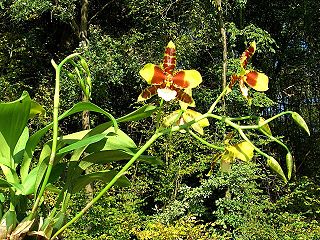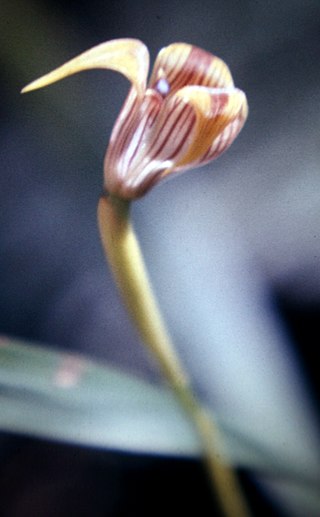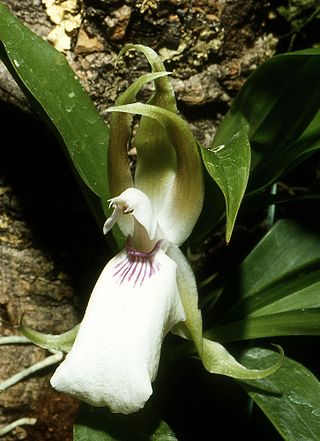
Arethusa bulbosa, commonly called dragon's mouth orchid, is the only species in the orchid genus Arethusa. The genus is named after a naiad of Greek mythology. This monotypic genus is abbreviated Aret in trade journals.

Dactylorhiza viridis, the frog orchid, is a species of flowering plant in the orchid family Orchidaceae. It has also been treated as the only species Coeloglossum viride of the monotypic genus Coeloglossum.

Prasophyllum, commonly known as leek orchids, is a genus of about 140 species of flowering plants in the orchid family, Orchidaceae and is found in Australia and New Zealand. The Australian species are found in all states but have not been recorded in the Northern Territory. The common name arises from their having a hollow, leek- or onion-like leaf. Some species only flower after summer fires and have flowers similar to those of Xanthorrhoea which flower at the same time, suggesting that they employ the same pollinating insects. Leek orchids are similar to those in the genus Genoplesium except that the free part of the leaf is cylindrical and the labellum has a solid connection to the column. They range in size from the little laughing leek orchid at about 15 cm (6 in) to the king leek orchid which grows up to 2 m (80 in) tall.

The ornamental orchid species Phalaenopsis hieroglyphica is native to certain islands of the Philippines. Its flowers are creamy white with transverse markings that resemble glyphs. Through hybridization, growers have successfully created flowers with different shapes and colors while retaining the glyphs. Since 1975, the species has been protected under Appendix II of the Convention on International Trade in Endangered Species of Wild Fauna and Flora (CITES).

Rossioglossum grande, one of several species known as tiger orchids, is an epiphytic orchid native to the area from Chiapas to Costa Rica. The plant may grow four to eight flowers, each up to 13 inches in diameter. The flowers are a glossy bright golden yellow with brown barring. Larger petals are yellow with the lower half red-brown. The lip is white and sometimes flecked with red-brown. The pseudobulbs are gray-green in color, and grow from 4 to 10 cm, each with two leaves.

Leptoceras menziesii, commonly known as rabbit orchid, is a plant in the orchid family, Orchidaceae and the only member of the genus Leptoceras. It is a slender plant, usually found in large colonies and which only flowers after fire. The flowers are small, white, pink and red on a stem up to 30 cm (10 in) tall and is endemic to southern Australia. It was one of the first orchids from Western Australia to be described and was given the name Caladenia menziesii, a name still used by some authorities.
Trigonidium, abbreviated as Trgdm in horticultural trade, was a formerly accepted genus of orchids comprising roughly twenty species found from Mexico to Brazil. As of 2023, it was considered a synonym of Maxillaria.

Lyperanthus, commonly known as beak orchids, is a genus of flowering plants from the orchid family, Orchidaceae, that is endemic to Australia. There are two species, one in Western Australia and the other in four eastern Australian states, distinguished by their single long, narrow, leathery leaf and dull coloured flowers which have prominent short calli on their labellum. Both form loose colonies which reproduce asexually from their tubers, and sexually using their flowers.

Pyrorchis, commonly known as beak orchids, is a genus of flowering plants in the orchid family, Orchidaceae and is endemic to Australia. It contains two species which were previously included in the genus Lyperanthus, also known as beak orchids. Both species have fleshy, oval leaves and form colonies which flower profusely after bushfires.

Spiculaea is a genus of plants defined by a single species, Spiculaea ciliata, commonly known as elbow orchid, and allied to the family Orchidaceae. Endemic to the south-west of Western Australia, the species is unusual in a number of respects; it grows in shallow soil on granite rock outcrops, grows and flowers in the hottest months of the year and has a unique method of using thynnid wasps as pollinators.

Zygopetalinae is an orchid subtribe in the tribe Cymbidieae with 418 species.

Prasophyllum elatum, commonly known as the tall leek orchid, snake orchid or piano orchid, is a species of orchid in the family Orchidaceae which is endemic to Australia. It is one of the tallest orchids found in Western Australia as well as one of the most common and widespread. It often flowers in large numbers after a bushfire and has a relatively long flowering period.

Zygopetalum maculatum is a species of orchid native to Peru, Bolivia and Brazil. The plants are mainly situated in flat, very wet, moss-covered, semi-boggy areas at elevations of 1,100 to 2,500 m.

Caladenia dimidia, commonly known as the chameleon orchid, is a species of orchid endemic to the south-west of Western Australia. It has a single hairy leaf and one or two yellow, cream-coloured or pinkish flowers. It is a variable species, similar to the Joseph's spider orchid but has a more northerly distribution and smaller flowers.

Caladenia abbreviata, commonly known as the coastal spider orchid, is a plant in the orchid family Orchidaceae and is endemic to the south-west of Western Australia. It has a single erect, hairy leaf and up to three pale, creamy-yellow flowers on a flowering stem up to 35 cm (10 in) high. Although the flowers have long, thread-like petals and sepals, they are shorter and darker than those of other spider orchids. It is a rare, relatively recently discovered species although often found near human activities.
Caladenia drakeoides, commonly known as the hinged dragon orchid, is a species of orchid endemic to the south-west of Western Australia. It has a single hairy leaf and a single greenish-yellow and red flower with a hinged labellum resembling a female thynnid wasp.

Maxillaria subrepens is an orchid found in tropical South America.

Maxillaria obtusa, synonym Trigonidium obtusum, is an orchid native to tropical South America.

Kefersteinia graminea is an orchid found in Venezuela, Colombia, and Ecuador. Euglossine bees pollinate the species.

Zygosepalum labiosum is an epiphytic orchid found in South America, growing in dense shade at up to 400 m (1,300 ft) in elevation.



















